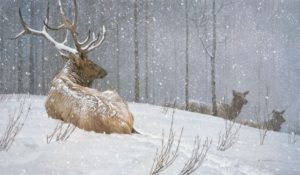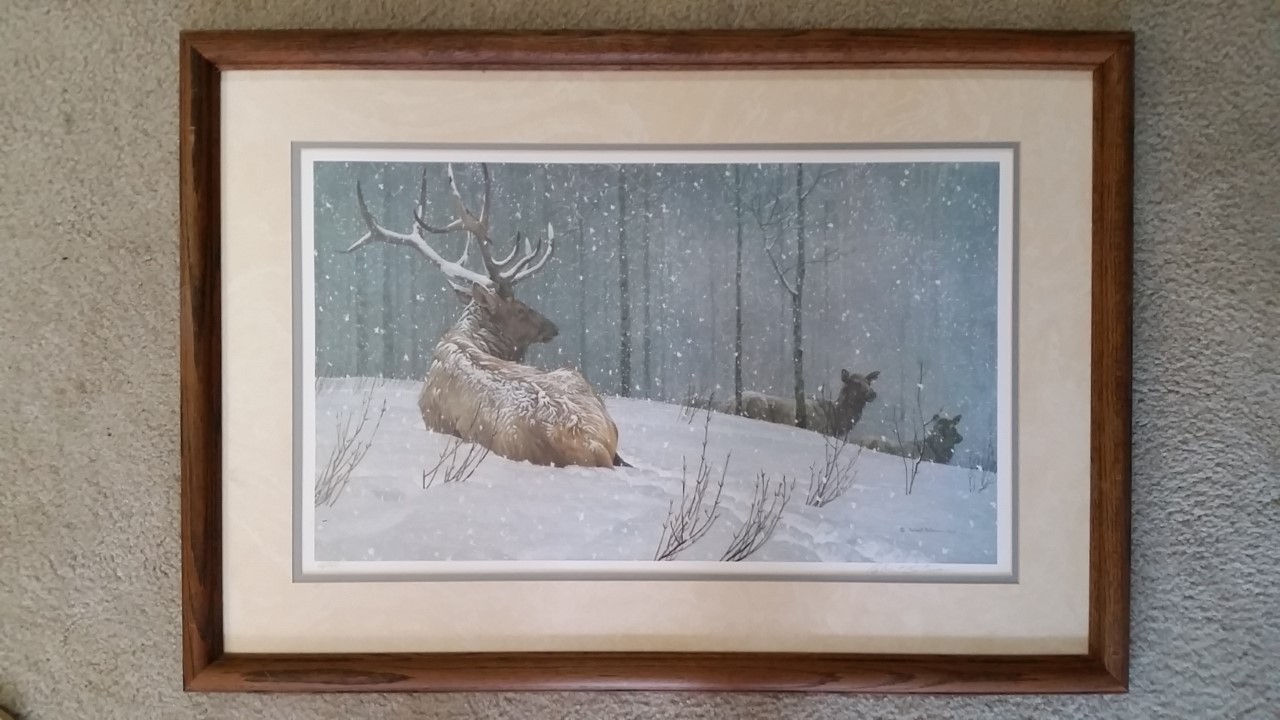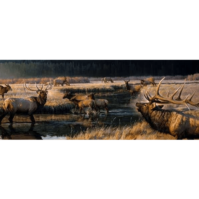Evening Snowfall-American Elk by Robert Bateman-framed consignment
Original price was: $1,675.00.$1,425.00Current price is: $1,425.00.
Description
Evening Snowfall-American Elk by Robert Bateman-framed consignment. Framed as shown from a private collection.“EVENING SNOWFALL – AMERICAN ELK ” Robert Bateman 950 s/n Paper 15.375″ x 23.375″ 1978, 28″ x 48″, Acrylic on Masonite
As night approaches, a gentle fall of snow drifts down in the aspen grove. It slowly coats the back of the big bull elk as he watches part of his herd move down the slope to a sheltered resting place. With the frenzy of the autumn rutting competition over, he can relax control of his harem. The American elk, or wapiti, is, next to the moose, the largest of the North American deer. A bull can weigh in the neighbourhood of one thousand pounds with antlers up to six feet long. In winter, the herds join in groups of up to one hundred in the more protected mountain valleys. In early times, the elk ranged over much of central North America. Due to hunting pressure it is now found in isolated pockets of unexploited habitats, mainly in the West. The European red deer is another race of this species found in places like the Scottish Highlands or the Black Forest of Germany. It is more reddish-brown and slighter in build than its American cousin.
Robert Bateman
“No deer have adapted better to human settlement than the roe deer. They are relatively small, 29 to 30 inches at the shoulder, and can easily hide in a farm field, hedgerow or wood lot. This is a big buck in a typical nervous pose as he comes out of the forest to graze the meadow in the early morning dew.” Robert Bateman
Robert Bateman (1930- ) is a Canadian naturalist, educator, and painter. As a young boy, Bateman was fascinated by his natural surroundings, particularly birds. He also enjoyed art, but did not intend to make it a career. After high school, he attended Forest Hill Collegiate Institute in Toronto, the University of Toronto, and the Ontario College of Education to earn degrees in geography and education. From there, he went on to spend 20 years as a high school art and geography teacher in Ontario and Nigeria. With his freetime during this period, he also continued to paint. By 1976, his artwork was beginning to gain recognition and he ended his career as a formal educator to devote more time to painting. In 1977 he signed with Mill Pond Press to begin distribution of his work as limited edition fine art prints.
Robert Bateman’s paintings are part of the realism genre of fine art, although he initially dabbled with representational, impressionistic, cubist, and abstract impressionistic art styles first. He was influenced by the members of the Group of Seven, a Canadian art movement from the early 20th century. Nearly all of his pieces feature an animal in their natural habitat. His subjects range from cardinals to grizzlies to whales, with birds being a favorite. Bateman’s artwork has been strongly influenced by his far-reaching travels, particularly a two year stint in a Land Rover traveling the world.
Over the course of his career, Robert Bateman’s art has been featured in more than 30 major one-man exhibitions, with most of the shows drawing record-breaking crowds. His pieces are in the private collections of Prince Philip, Princess Grace of Monaco, and Prince Bernard of the Netherlands as well as the permanent collections of many museums. He has done commissioned work for the World Wildlife Fund, the Canada Post, the Toronto Board of Trade, the Royal Canadian Mint, the National Capital Commission, and even a piece entitled “Northern Reflections – Loon Family” which was given to Prince Charles as a gift from the Canadian Government. Bateman has received twelve honorary degrees and in excess of 30 major awards, including two Queen’s Jubilee medals and the Order of British Columbia. There are three Canadian schools named after him. He has authored or co-authored a dozen books on his life, his art, and wildlife. He has been the subject of at least ten different feature films over the course of three decades and has affiliations with the board or commission of more than forty environment and art related organizations. In addition to his artwork, he started the Get to Know program to help educate children about their natural surroundings.





